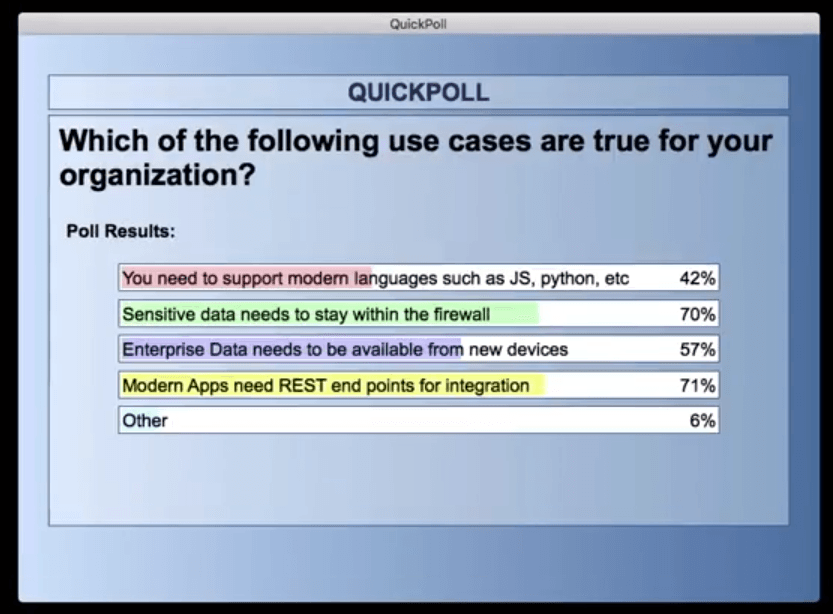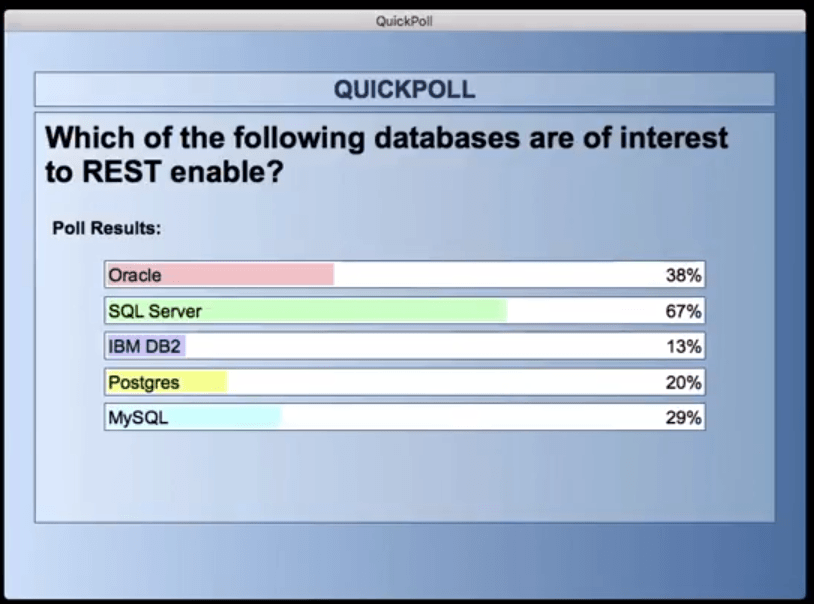N
Nishanth Kadiyala
Guest
Learn what's new in REST APIs for databases, and how you can use REST and OData to improve the way you securely access data from web and mobile. Catch a demo in our on-demand webinar too.
Our recent webinar, What’s New in REST APIs for Your Database, has been one of our most popular to date, with hundreds of attendees signing up to learn about REST and OData for data access.
Why has this topic resonated so broadly? Securely accessing data from web and mobile applications is a challenge confronting every organization in every industry. Users expect to have fast, accurate data available at their fingertips.
REST and OData are the solution. What is OData, and how did we get here? Read on to learn more!
Modern Data Access Patterns
Data access has evolved from mainframe to relational to the current world of data distributed across many sources. While data warehouses are still a workhorse for many organizations, the concept of a “nightly batch” has become archaic—what is “nightly” for a global company? Plus, data warehouses can be inherently time consuming to build and maintain.
Data lakes have come to the forefront as a replacement for the data warehouse because data lakes can ingest more types of data in larger quantities. Unfortunately, data lakes tend to turn into data swamps when the focus is more on collecting data rather than on connecting data. Plus, concerns about data privacy and security can inhibit the usefulness of a lake.
The modern data access method, therefore, leaves data in place while connecting to it via REST APIs.
Easy Access of REST APIs from HTML5, Web and Mobile Apps
REST APIs allow you to continue leveraging existing investment in data storage, while securely opening that data to web and mobile apps without actually moving or copying the data. The HTML5, web or mobile applications can access the data in real-time via the REST APIs. But because every database REST API is different, you need OData.
OData is an open protocol to allow the creation and consumption of query-able and interoperable REST-ful APIs in a simple and standard way. While every database REST API is unique, OData is both an industry standard and an international standard, and is sometimes called “SQL for the web.”
The OData API works by mapping its constructs and query options to database and SQL constructs. Likewise, HTTP methods map to OData REST Operations and SQL Commands.
Progress DataDirect delivers a single point of OData configuration for all data sources. With one interface, you can create OData endpoints to each of your data stores. Then, connect to those endpoints with your application. Our webinar includes an OData demo, so if you’re new to OData check it out to view the demo in action.
How are Organizations Using OData?
Use of REST and OData APIs are increasing. In the 2017 Data Access survey we learned that 71% of companies were using OData or REST. In our recent webinar, we asked our attendees why their companies are adopting the OData standard:

Sensitive data needs to stay within the firewall: This speaks to the exact reason why many companies no longer want to use the data warehouse or data lake model. Data needs to remain in place, behind corporate firewalls, rather than moving into various repositories or into the cloud. Data security concerns are rising every day, and they are only going to increase. Leaving data in place and adding an extra layer of additional control isn’t just nice to have—it’s a necessity.
Modern Apps need REST end points for integration: By combining modern applications built with JSON, Nativescript, Python, Ruby, etc. with OData endpoints, data access and integration becomes seamless and simplified. No longer do databases have to be difficult for application developers to integrate with. But those modern applications need the implementation of REST endpoints to make integration happen.
What Data Sources are Most In-Demand for REST Enablement?
We offered survey participants two sets of choices for the data sources they need to REST-enable. See both sets of answers below:


Amongst our webinar attendees, the most popular data sources to RESTify were SQL Server, OpenEdge, MySQL and the Hadoop Frameworks.
While relational data stores can often be labeled as “legacy,” this survey verifies our experience that the vast majority of businesses in the world still run on the largest relational databases. The movement toward the web and modern applications doesn’t replace the need to use traditional relational data. Instead, OData opens a new way to access those traditional sources of data with new, cutting-edge applications.
Learn More
Ready to learn more about data access trends, why companies are REST-ifying data and see a demo of OData in action? Watch our webinar today!
Watch Webinar
Continue reading...
Our recent webinar, What’s New in REST APIs for Your Database, has been one of our most popular to date, with hundreds of attendees signing up to learn about REST and OData for data access.
Why has this topic resonated so broadly? Securely accessing data from web and mobile applications is a challenge confronting every organization in every industry. Users expect to have fast, accurate data available at their fingertips.
REST and OData are the solution. What is OData, and how did we get here? Read on to learn more!
Modern Data Access Patterns
Data access has evolved from mainframe to relational to the current world of data distributed across many sources. While data warehouses are still a workhorse for many organizations, the concept of a “nightly batch” has become archaic—what is “nightly” for a global company? Plus, data warehouses can be inherently time consuming to build and maintain.
Data lakes have come to the forefront as a replacement for the data warehouse because data lakes can ingest more types of data in larger quantities. Unfortunately, data lakes tend to turn into data swamps when the focus is more on collecting data rather than on connecting data. Plus, concerns about data privacy and security can inhibit the usefulness of a lake.
The modern data access method, therefore, leaves data in place while connecting to it via REST APIs.
Easy Access of REST APIs from HTML5, Web and Mobile Apps
REST APIs allow you to continue leveraging existing investment in data storage, while securely opening that data to web and mobile apps without actually moving or copying the data. The HTML5, web or mobile applications can access the data in real-time via the REST APIs. But because every database REST API is different, you need OData.
OData is an open protocol to allow the creation and consumption of query-able and interoperable REST-ful APIs in a simple and standard way. While every database REST API is unique, OData is both an industry standard and an international standard, and is sometimes called “SQL for the web.”
The OData API works by mapping its constructs and query options to database and SQL constructs. Likewise, HTTP methods map to OData REST Operations and SQL Commands.
Progress DataDirect delivers a single point of OData configuration for all data sources. With one interface, you can create OData endpoints to each of your data stores. Then, connect to those endpoints with your application. Our webinar includes an OData demo, so if you’re new to OData check it out to view the demo in action.
How are Organizations Using OData?
Use of REST and OData APIs are increasing. In the 2017 Data Access survey we learned that 71% of companies were using OData or REST. In our recent webinar, we asked our attendees why their companies are adopting the OData standard:

Sensitive data needs to stay within the firewall: This speaks to the exact reason why many companies no longer want to use the data warehouse or data lake model. Data needs to remain in place, behind corporate firewalls, rather than moving into various repositories or into the cloud. Data security concerns are rising every day, and they are only going to increase. Leaving data in place and adding an extra layer of additional control isn’t just nice to have—it’s a necessity.
Modern Apps need REST end points for integration: By combining modern applications built with JSON, Nativescript, Python, Ruby, etc. with OData endpoints, data access and integration becomes seamless and simplified. No longer do databases have to be difficult for application developers to integrate with. But those modern applications need the implementation of REST endpoints to make integration happen.
What Data Sources are Most In-Demand for REST Enablement?
We offered survey participants two sets of choices for the data sources they need to REST-enable. See both sets of answers below:


Amongst our webinar attendees, the most popular data sources to RESTify were SQL Server, OpenEdge, MySQL and the Hadoop Frameworks.
While relational data stores can often be labeled as “legacy,” this survey verifies our experience that the vast majority of businesses in the world still run on the largest relational databases. The movement toward the web and modern applications doesn’t replace the need to use traditional relational data. Instead, OData opens a new way to access those traditional sources of data with new, cutting-edge applications.
Learn More
Ready to learn more about data access trends, why companies are REST-ifying data and see a demo of OData in action? Watch our webinar today!
Watch Webinar
Continue reading...
